31.07.19
Holyrood Gem Opens and an International Flavour to Tasting This Month
Hello all and I hope you’re enjoying a good summer or not too hard a winter wherever you’re reading this.
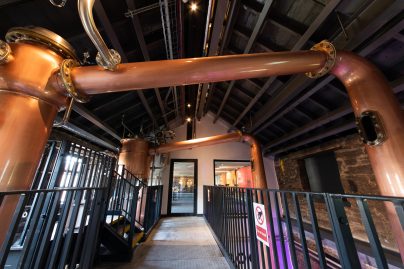 On Tuesday 30th July, I was fortunate enough to attend the opening of the new Holyrood Distillery in Edinburgh. It’s a location quite close to the city centre and what a fabulous job they’ve done. The lovely shop and walk through of the distillery are in chic, dark colours (except the light and colourful gin tasting area) and it’s easy to follow with good information. Great staff too and it was a pleasure to meet as many of them as possible at a crowded opening event.
On Tuesday 30th July, I was fortunate enough to attend the opening of the new Holyrood Distillery in Edinburgh. It’s a location quite close to the city centre and what a fabulous job they’ve done. The lovely shop and walk through of the distillery are in chic, dark colours (except the light and colourful gin tasting area) and it’s easy to follow with good information. Great staff too and it was a pleasure to meet as many of them as possible at a crowded opening event.
Holyrood Distillery is the dream and creation of David Robertson, who has worked for a couple of major distillers in the past in the blend and whisky creation areas – as well as founding Rare Whisky 101 – and of Rob and Kelly Carpenter, a Canadian couple (and surely, now, honorary Scots!) who all raised funding to bring distilling back to our Scottish capital. It’s the first Edinburgh city distillery for nearly 100 years and cost £6.7 million as well as taking a year to build and kit out and astounding to have done it all in that short time. Well worth it as it employs 30 people too.
The distillery is tucked into a location easily reachable by public transport and then a short walk. They’re in a residential area and want to be good neighbours so there is no parking offered as the area’s streets are already busy with residents’ parking. They’re encouraging visitors to come by public transport and I heard talk last night of maybe offering an incentive at some point in the visit to those who do that. As it stands at present, tour tickets start at £14 for adults.
At the moment the distillery produces only gins and gin liqueurs but they are many, varied, some beautifully coloured and highly enticing. Nice packaging too. I tried just a little of their classic gin (sadly, I was driving) which is quite forward with the juniper but, as Charlie Maclean pointed out, that’s what gin is all about. The gin still is a baby still gleaming with copper and stainless steel as is all the whisky production equipment downstairs.
David Robertson is hoping to start the first spirit production in the first half of August. There are five mash tuns for the whisky, one spirit still and one wash still. It’s a one tonne mash, a 5,000 litre wash still and 3,750 litre spirit still. The stills are very tall at around 7 metres which would give some clue to the style of whisky they want to produce but it ‘s not that simple…The team here wants to “focus on innovation and the creation of robust flavours through different production approaches”. I was delighted to hear that they intend to use different types of malted barley – some of which are used already by brewers – and yeasts to see what spirit they produce. I find the areas of barley and yeast research fascinating and reckon we have a lot more to learn. It will be so interesting to find out what each individual barley or yeast strain produces and then to offer either singly or in a single malt from several different types. The combinations could be numerous. They intend to look at four flavour profiles: smoky, fruity/floral, sweet and spicy. Whisky from caramel or roasted coffee malt anyone? Brilliant idea.
Distillery manager is Dr. Jack Mayo. I asked him to tell me more about the retort tank he is adding to the stills as Rob Carpenter had mentioned that to me. It’s the only one in Scotland and derived from the kind of thing seen in Caribbean rum distilleries. Jack was kind enough to draw little rough pictures of still evolution for me but it’s one of those things I’m going to have to go back and see in action for myself and maybe even stick my head in, if possible, to appreciate it more fully. A bit like seeing the distilling at Mortlach which I’ve been meaning to do for years. Seeing is believing or, in this case, understanding.
I certainly intend to try to use this distillery for the tailor-made tours I create for clients and urge everyone to go and see it if you can. But remember to cycle or take the bus.
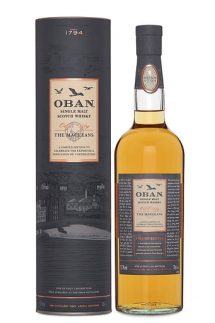 In other news, just today (31 July) Oban Distillery announced Oban Old Teddy – a Single Malt Scotch whisky that will be exclusively available at the distillery. “Skilfully crafted to deliver a delightful balance of distillery character and cask influence, this bottle is inspired by the unique and personal stories of those who are closely entwined with the liquid and its heritage – the Maclean family. Oban Old Teddy celebrates 66 years of Maclean family service at the distillery and highlights the expertise and dedication passed on from three generations. A distinctive release with true Oban character, on the nose, it opens with ripe orchard fruits, dried berries, and the signature Oban citrus peel. Matured using ex-bodega sherry casks and refill casks, it’s a truly special treat. The fruity characters remain evident on the palate with a warming, woody spice and burnt oranges. Adding a splash of water makes these fruity characters more pronounced.”
In other news, just today (31 July) Oban Distillery announced Oban Old Teddy – a Single Malt Scotch whisky that will be exclusively available at the distillery. “Skilfully crafted to deliver a delightful balance of distillery character and cask influence, this bottle is inspired by the unique and personal stories of those who are closely entwined with the liquid and its heritage – the Maclean family. Oban Old Teddy celebrates 66 years of Maclean family service at the distillery and highlights the expertise and dedication passed on from three generations. A distinctive release with true Oban character, on the nose, it opens with ripe orchard fruits, dried berries, and the signature Oban citrus peel. Matured using ex-bodega sherry casks and refill casks, it’s a truly special treat. The fruity characters remain evident on the palate with a warming, woody spice and burnt oranges. Adding a splash of water makes these fruity characters more pronounced.”
Available to purchase from July 2019 onwards, Oban Old Teddy will retail at £150 per 70cl bottle and comes in at 51.7% ABV. The release will be a limited edition of only 3,960 bottles.
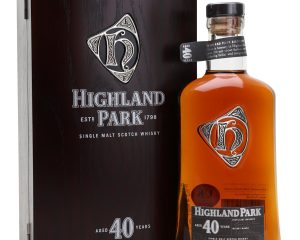
At the beginning of July I went to an event in The Dunstane Houses hotel in Edinburgh as they are the only hotel in Edinburgh to be getting a supply of the Highland Park 40 Year Old. It was to launch their exclusivity of that expression as the owners have family connections to Orkney. Sadly, no tasting of that as it’s far too expensive (£160 a dram, if I heard correctly) but one lucky person won a tutored tasting of it with Brand Ambassador, Martin Markvardssen. However, it was good to see Martin again and listen to good stories. Seems the key market for 40 year old is Sweden. Now, a 40 Year Old would cost a fortune anywhere but must be particularly expensive up there.
For the following week I had been invited to a tasting in Edinburgh of some Japanese whiskies from the Eigashima distillery which is the one closest to the coast in Japan. I 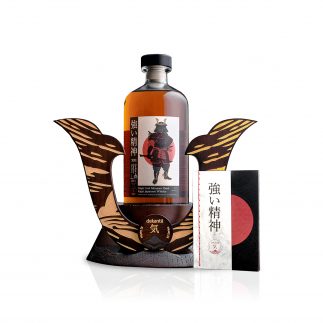 couldn’t go so Miriam, their super PR person in Scotland, met me later with some tasting samples and information. I really enjoyed trying them and spent a lot of time nosing in particular. Despite having some Japanese whiskies at home, I’m not too familiar with it so tried to set aside any usual vocabulary I might use for Scotch Whisky. Daft really as you nose what you nose and taste what you taste, no matter where it comes from. You just have to fond words for something that’s new to you. Miriam had told me what cask types were used in maturation but I preferred not to look at their tasting notes before trying them myself.
couldn’t go so Miriam, their super PR person in Scotland, met me later with some tasting samples and information. I really enjoyed trying them and spent a lot of time nosing in particular. Despite having some Japanese whiskies at home, I’m not too familiar with it so tried to set aside any usual vocabulary I might use for Scotch Whisky. Daft really as you nose what you nose and taste what you taste, no matter where it comes from. You just have to fond words for something that’s new to you. Miriam had told me what cask types were used in maturation but I preferred not to look at their tasting notes before trying them myself.
She gave me three whiskies. Two were from their Ki Series – Kikou and Kigai, which are private label bottlings for the this company, dekanta (yes, it’s written without a capital D). The other was Kamiki Sakura, not a private label. It spent time in Japanese cedar wood and Kamiki Intense spent longer in cask. This latest Kimiki was in both cedar wood then in sakura (cherry ) wood for a time. Kikou at 58.4% abv and meaning “climate”, was bottled to celebrate the dekanta company’s third anniversary in 2018 and was distilled in 2011, bottled in 2017. Maturation was in a “freshly emptied Port Ellen Whisky cask”. Now you might think that would pack a real smoky punch between the eyes but it’s much more subtle than that.
The Kigai expression, meaning “strong spirit” or “resolve”, was bottled this year for their fourth anniversary. It was also distilled in 2011 and matured first in a freshly emptied cask which had held a peated whisky before being racked into a cask of Japanese mizunara oak which imparts a spicier, sandalwood-like note. 60% abv. The three were all quite different though Kikou and Kigai have some similarities from the smoky/char notes.
Kigai had something of a menthol effect on the nose, with spiciness and sandalwood and usual oak notes. It’s quite stimulating. Left a while it gets sweeter and fruitier with some smoke/char. With water there’s also something slightly leafy about it. It’s a really unusual sensation on the palalte- both cooling and hot; peppery An interesting juxtaposition. Some 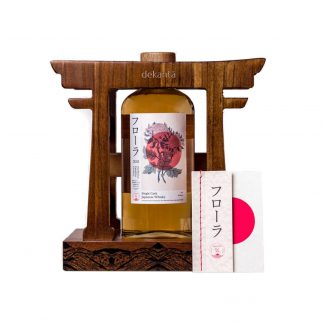 more earthy and peaty notes too. Finish is medium with some wood and herbal notes + pepper and spice.
more earthy and peaty notes too. Finish is medium with some wood and herbal notes + pepper and spice.
Kikou is similar in tone to Kigai but a little paler. Although a bit younger it seems a bit mellower and fruitier than Kigai. A dab of almond at the back; soft candy notes. Left a while, more toast, smoke and char comes through. With water there was a brief waft of sulphur not noticed before. Also the slightly minty freshness of Kigai but much less pronounced. Woody spices, oak and dried stone fruits; wax; then fruity again. Musky floral notes and smoke. For me, it had the most complex aroma of the three. The palate offered softness then wood notes; fruit and pepper; sweet spices and a touch of bitters. Finish was medium length and quite mellow but with some zingy pepper notes, musky, woody and some smoke.
Not meaning to do it down, but the Kamiki Sikura had the colour of Irn Bru i.e. orange! To be fair cherry wood can possess that colouring and some of it may well have come from the cask. Baked orange notes and some dried stone fruit. It nosed a little richer than Kigai but somehow less complex. Perhaps it needed more time. Left a while more spiritous notes developed (age was not mentioned) and something akin to lychee and to varnish. With water more like light fruit cake and some soft spices. Then more sweetness comes through; a bit of banana. Jelly Babies! The palate initally gave me ripe banana, spices, sweet wood; something slightly “green” also – leafy and green peppercorns.
Kikou and Kigai and more information can be found at www.dekanta.com but be warned, they’re not cheap bottles and are limited production of only 300 bottles (Kikou) and 352 bottles (Kigai). Kigai is around US$750.
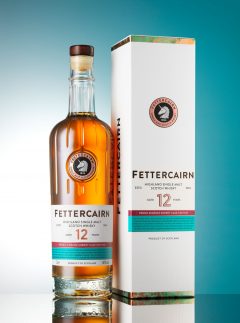 The other whisky on taste this month is a travel retail exclusive from Fettercairn. You may recall they launched a new range about this time last year, showing a 12 year old and several older whiskies which were really enjoyable though I liked some more than others. This one is a 12 Year Old PX at 40% abv with the time in PX cask to add more complexity and sweetness. Fettercairn is a divinely fruity malt and this one carries that on but in a slightly different way.
The other whisky on taste this month is a travel retail exclusive from Fettercairn. You may recall they launched a new range about this time last year, showing a 12 year old and several older whiskies which were really enjoyable though I liked some more than others. This one is a 12 Year Old PX at 40% abv with the time in PX cask to add more complexity and sweetness. Fettercairn is a divinely fruity malt and this one carries that on but in a slightly different way.
Appearance: Amber and orange; tears quite swift then slower and stickier in appearance.
Nose: Spicy and richly fruity but, initially, not so much raisin but more perfumed fruits like juicy apricots and mangoes with baked pineapple (the latter a bit more muted than in other expressions) Some earthy tones. With water it is softer and a bit more waxy at first; a touch more oak and earth. Quite a sweet nose with plenty of layers. Nosing the empty bottle there are sweet soaked sultanas and raisins as for a Christmas cake; some vanilla but mainly sweet dried fruit and a bit of orange oil.
Palate: Slightly unctuous; medium-bodied; sweetness of dried fruits again; heathery dryness and warm spices – not just sweet ones. Some fine oak tannins, a little bitterness and some wax. Quite rounded and mellow.
Finish: Medium length; both dry and sweet notes; some sweet grassiness. Definitely a moreish dram. I think I’d like to drink this without much water.
Earlier this month we had news of some new Glenallachie expressions. its first-ever range of limited edition wood finishes consisting of 8 year old Koval Rye Quarter Cask 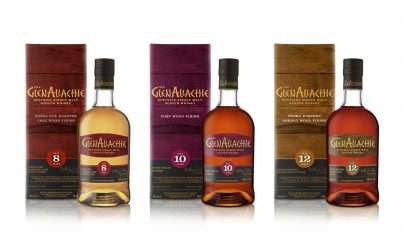 Wood Finish; the 10 year old Port Wood Finish; and the 12 year old Pedro Ximenez Sherry Wood Finish.
Wood Finish; the 10 year old Port Wood Finish; and the 12 year old Pedro Ximenez Sherry Wood Finish.
“The 8 year old Koval Rye Quarter Cask Wood Finish was first matured in American oak wood barrels and then underwent an additional maturation period in organic Rye quarter casks from Chicago’s Koval Distillery. The greater liquid-to-wood ratio in the smaller casks means that the rich spicy flavour of the Rye is released more rapidly.
With its distinctive ruby red colour, the 10 year old Port Wood Finish was first matured in American oak barrels before being re-racked into vintage Ruby Port wood pipes sourced in North Portugal. The Port wood influence adds flavour, depth and complexity to the whisky, with sweet notes of heather honey, butterscotch and treacle.
The 12 year old Pedro Ximenez Sherry Wood Finish is a rich sumptuous whisky with great depth. This whisky was matured for over ten years in American oak wood barrels before its additional maturation in Pedro Ximenez puncheons. This process enriches the flavour, creating a sweeter, fruitier whisky.”
No samples so I can’t supply tasting notes of my own but, they’re a company aiming for high quality so I think they’d be worth seeking out.
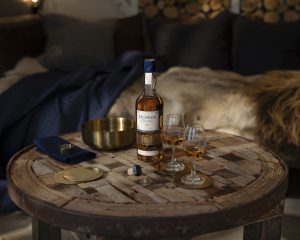 From August, Talisker will unveil the second release of only 2,000 bottles from the Talisker Bodega Series and the oldest official Single Malt, to date, from Skye’s oldest distillery: a 41-year-old 1978 Vintage. Available at selected luxury retailers globally from August 2019 onwards, the Talisker 41-Year-Old is retailing at RRSP of £2,900 per 70cl bottle. Bottled at 50.7% ABV. Not one for the masses at that price but it will surely sell out.
From August, Talisker will unveil the second release of only 2,000 bottles from the Talisker Bodega Series and the oldest official Single Malt, to date, from Skye’s oldest distillery: a 41-year-old 1978 Vintage. Available at selected luxury retailers globally from August 2019 onwards, the Talisker 41-Year-Old is retailing at RRSP of £2,900 per 70cl bottle. Bottled at 50.7% ABV. Not one for the masses at that price but it will surely sell out.
The Talisker Bodega Series is an exploration of sherry cask finishes on the finest of Talisker Single Malt Whiskies. The second in the trilogy, the 41-year-old has been expertly finished in Manzanilla Sherry casks from Delgado Zuleta, the oldest Sherry producer in the famed Sherry Triangle. Located in the Marco de Jerez region, next to the coastal town of Sanlúcar de Barrameda, it is where Talisker distillery revealed a trading connection that dates to 1900. Talisker’s Master Blender, Dr Craig Wilson, helped to craft the precious 41-year-old liquid, working alongside the Sherry Masters at Bodega Delgado Zuleta. The sherry experts hand-picked only six exceptional casks for finishing, that once held the Bodega’s flagship wine La Goya, a very fine Manzanilla aged in casks more than a century old.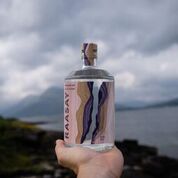
Harking back to gin just for a second (Whisky Ambassador runs gin courses too), Isle of Raasay Distillery has launched its new gin. Lovely packaging. I thought the design might be taken from the rock formations and their colours on the island. Turns out I was right. Do try some.
We’re finally done for this month except to say that next month’s column will be in form of an interview with one of the nicest little whisky companies I know.
Till then, happy dramming.
Caroline
Comments